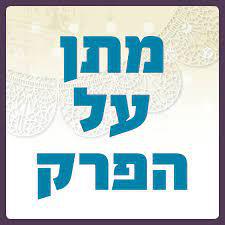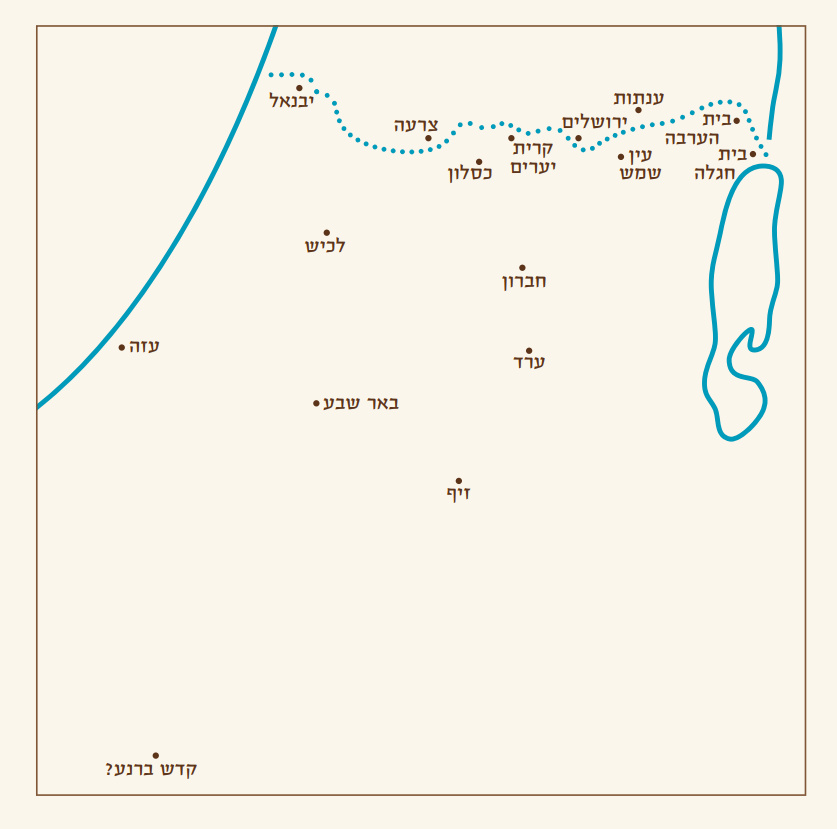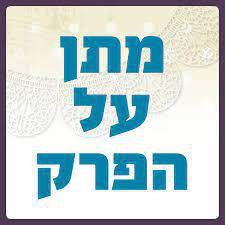

בפרקים מפורטות נחלות בני יהודה ובני יוסף יחד עם סיפורה המופלא של עכסה בת כלב. פרטי התיאור, אורכו ודרך כתיבתו, מלמדים אותנו רבות על היחס בין השבטים והשלבים השונים בירושת הארץ.
וַֽיִּקְרְא֥וּ בַסֵּ֛פֶר בְּתוֹרַ֥ת הָאֱלֹהִ֖ים - בקיאות
(1) The portion that fell by lot to the various clans of the tribe of Judah lay farthest south, down to the border of Edom, which is the Wilderness of Zin. (2) Their southern boundary began from the tip of the Dead Sea, from the tongue that projects southward. (3) It proceeded to the south of the Ascent of Akrabbim, passed on to Zin, ascended to the south of Kadesh-barnea, passed on to Hezron, ascended to Addar, and made a turn to Karka. (4) From there it passed on to Azmon and proceeded to the Wadi of Egypt; and the boundary ran on to the Sea. That shall be your southern boundary. (5) The boundary on the east was the Dead Sea up to the mouth of the Jordan. On the northern side, the boundary began at the tongue of the Sea at the mouth of the Jordan. (6) The boundary ascended to Beth-hoglah and passed north of Beth-arabah; then the boundary ascended to the Stone of Bohan son of Reuben. (7) The boundary ascended from the Valley of Achor to Debir and turned north-a to Gilgal, facing the Ascent of Adummim which is south of the wadi; from there the boundary continued to the waters of En-shemesh and ran on to En-rogel. (8) Then the boundary ascended into the Valley of Ben-hinnom, along the southern flank of the Jebusites—that is, Jerusalem. The boundary then ran up to the top of the hill which flanks the Valley of Hinnom on the west, at the northern end of the Valley of Rephaim. (9) From that hilltop the boundary curved to the fountain of the Waters of Nephtoah and ran on to the towns of Mount Ephron; then the boundary curved to Baalah—that is, Kiriath-jearim. (10) From Baalah the boundary turned westward to Mount Seir, passed north of the slope of Mount Jearim—that is, Chesalon—descended to Beth-shemesh, and passed on to Timnah. (11) The boundary then proceeded to the northern flank of Ekron; the boundary curved to Shikkeron, passed on to Mount Baalah, and proceeded to Jabneel; and the boundary ran on to the Sea. (12) And the western boundary was the edge of the Mediterranean Sea. Those were the boundaries of the various clans of the Judites on all sides. (13) In accordance with the LORD’s command to Joshua, Caleb son of Jephunneh was given a portion among the Judites, namely, Kiriath-arba—that is, Hebron. ([Arba] was the father of Anak.) (14) Caleb dislodged from there the three Anakites: Sheshai, Ahiman, and Talmai, descendants of Anak. (15) From there he marched against the inhabitants of Debir—the name of Debir was formerly Kiriath-sepher— (16) and Caleb announced, “I will give my daughter Achsah in marriage to the man who attacks and captures Kiriath-sepher.” (17) His kinsman Othniel the Kenizzite captured it; and Caleb gave him his daughter Achsah in marriage. (18) When she came [to him], she induced him-e to ask her father for some property. She dismounted from her donkey, and Caleb asked her, “What is the matter?” (19) She replied, “Give me a present; for you have given me away as Negeb-land; so give me springs of water.” And he gave her Upper and Lower Gulloth. (20) This was the portion of the tribe of the Judites by their clans: (21) The towns at the far end of the tribe of Judah, near the border of Edom, in the Negeb, were: Kabzeel, Eder, Jagur, (22) Kinah, Dimonah, Adadah, (23) Kedesh, Hazor, Ithnan, (24) Ziph, Telem, Bealoth, (25) Hazor-hadattah, Kerioth-hezron—that is, Hazor— (26) Amam, Shema, Moladah, (27) Hazar-gaddah, Heshmon, Beth-pelet, (28) Hazar-shual, Beer-sheba, Biziothiah, (29) Baalah, Iim, Ezem, (30) Eltolad, Chesil, Hormah, (31) Ziklag, Madmannah, Sansannah, (32) Lebaoth, Shilhim,-h Ain and Rimmon. Total: 29 towns, with their villages. (33) In the Lowland: Eshtaol, Zorah, Ashnah, (34) Zanoah, En-gannim, Tappuah, Enam, (35) Jarmuth, Adullam, Socoh, Azekah, (36) Shaaraim, Adithaim, Gederah, and Gederothaim—14 towns, with their villages. (37) Zenan, Hadashah, Migdal-gad, (38) Dilan, Mizpeh, Joktheel, (39) Lachish, Bozkath, Eglon, (40) Cabbon, Lahmas, Chithlish, (41) Gederoth, Beth-dagon, Naamah, and Makkedah: 16 towns, with their villages. (42) Libnah, Ether, Ashan, (43) Iphtah, Ashnah, Nezib, (44) Keilah, Achzib, and Mareshah: 9 towns, with their villages. (45) Ekron, with its dependencies and villages. (46) From Ekron westward, all the towns in the vicinity of Ashdod, with their villages— (47) Ashdod, its dependencies and its villages—Gaza, its dependencies and its villages, all the way to the Wadi of Egypt and the edge of the Mediterranean Sea. (48) And in the hill country: Shamir, Jattir, Socoh, (49) Dannah, Kiriath-sannah—that is, Debir— (50) Anab, Eshtemoh, Anim, (51) Goshen, Holon, and Giloh: 11 towns, with their villages. (52) Arab, Dumah, Eshan, (53) Janum, Beth-tappuah, Aphekah, (54) Humtah, Kiriath-arba—that is, Hebron—and Zior: 9 towns, with their villages. (55) Maon, Carmel, Ziph, Juttah, (56) Jezreel, Jokdeam, Zanoah, (57) Kain, Gibeah, and Timnah: 10 towns, with their villages. (58) Halhul, Beth-zur, Gedor, (59) Maarath, Beth-anoth, and Eltekon: 6 towns, with their villages. (60) Kiriath-baal—that is, Kiriath-jearim—and Rabbah: 2 towns, with their villages. (61) In the wilderness: Beth-arabah, Middin, Secacah, (62) Nibshan, Ir-melah, and En-gedi: 6 towns, with their villages. (63) But the Judites could not dispossess the Jebusites, the inhabitants of Jerusalem; so the Judites dwell with the Jebusites in Jerusalem to this day.
1.
הפרק מורכב משתי רשימות (א׳-י"ב; כ׳-ס"ג) וביניהן סיפור מעשה עכסה (י"ג-י"ט). מה מאפיין כל רשימה? מדוע לדעתכם נחלת יהודה מפורטת פעמיים?
2.
גבולות הנחלות מתוארים באמצעות הכיוונים: קדם, נגב, ים וצפון, והמילים: ירד, תאר, נסב ועלה.
העזרו במילים המנחות ונסו להכיר את נחלת יהודה לפרטיה באמצעות המפה המצורפת. (לפירוש המילה ׳תאר׳ עיינו ברש"י לפסוק ט׳).
הפרק מורכב משתי רשימות (א׳-י"ב; כ׳-ס"ג) וביניהן סיפור מעשה עכסה (י"ג-י"ט). מה מאפיין כל רשימה? מדוע לדעתכם נחלת יהודה מפורטת פעמיים?
2.
גבולות הנחלות מתוארים באמצעות הכיוונים: קדם, נגב, ים וצפון, והמילים: ירד, תאר, נסב ועלה.
העזרו במילים המנחות ונסו להכיר את נחלת יהודה לפרטיה באמצעות המפה המצורפת. (לפירוש המילה ׳תאר׳ עיינו ברש"י לפסוק ט׳).

3.
עיינו בברכת יעקב ליהודה בבראשית מ"ט, ח׳-י"ב, ובברכת משה לשבט יהודה בדברים ל"ג, ז׳. בדקו כיצד הברכות השונות מתממשות כבר בפרקנו ובפרק י"ד. להשוואה עיינו ברפרוף בפרקים י"ח-י"ט.
עיינו בברכת יעקב ליהודה בבראשית מ"ט, ח׳-י"ב, ובברכת משה לשבט יהודה בדברים ל"ג, ז׳. בדקו כיצד הברכות השונות מתממשות כבר בפרקנו ובפרק י"ד. להשוואה עיינו ברפרוף בפרקים י"ח-י"ט.
(1) The portion that fell by lot to the Josephites ran from the Jordan at Jericho—from the waters of Jericho east of the wilderness. From Jericho it ascended through the hill country to Bethel. (2) From Bethel it ran to Luz and passed on to the territory of the Archites at Ataroth, (3) descended westward to the territory of the Japhletites as far as the border of Lower Beth-horon and Gezer, and ran on to the Sea. (4) Thus the Josephites—that is, Manasseh and Ephraim—received their portion. (5) The territory of the Ephraimites, by their clans, was as follows: The boundary of their portion ran from Atroth-addar on the east to Upper Beth-horon, (6) and the boundary ran on to the Sea. And on the north, the boundary proceeded from Michmethath to the east of Taanath-shiloh and passed beyond it up to the east of Janoah; (7) from Janoah it descended to Ataroth and Naarath, touched on Jericho, and ran on to the Jordan. (8) Westward, the boundary proceeded from Tappuah to the Wadi Kanah and ran on to the Sea. This was the portion of the tribe of the Ephraimites, by their clans, (9) together with the towns marked off for the Ephraimites within the territory of the Manassites—all those towns with their villages. (10) However, they failed to dispossess the Canaanites who dwelt in Gezer; so the Canaanites remained in the midst of Ephraim, as is still the case. But they had to perform forced labor.
4.
עיינו בפסוק ט׳ ושימו לב למיקומן של ערי אפרים בתוך נחלת מנשה. כיצד יכול להיווצר מצב זה ומה אפשר ללמוד מכך על תהליך ההתנחלות?
עיינו בפסוק ט׳ ושימו לב למיקומן של ערי אפרים בתוך נחלת מנשה. כיצד יכול להיווצר מצב זה ומה אפשר ללמוד מכך על תהליך ההתנחלות?
מְפֹרָ֑שׁ וְשׂ֣וֹם שֶׂ֔כֶל - עיון
5.
"וַיֹּאמֶר כָּלֵב אֲשֶׁר יַכֶּה אֶת קִרְיַת סֵפֶר וּלְכָדָהּ וְנָתַתִּי לוֹ אֶת עַכְסָה בִתִּי לְאִשָּׁה" (יהושע ט"ו, ט"ז). עיינו בבראשית רבה ס׳, ג׳ (מצוטט להלן) וחשבו מדוע נוקט כלב בדרך פעולה כזו, מהם התנאים להצלחתה ומה דעתם של חז"ל עליה.
בראשית רבה (תיאודור-אלבק) ס׳, ג׳: "ארבעה הן שתבעו שלא כהוגן, לשלשה ניתן להם כהוגן ולאחד ניתן לו שלא כהוגן, ואילו הן אליעזר וכלב ושאול ויפתח. אליעזר - "וְהָיָה הַנַּעֲרָ אֲשֶׁר אֹמַר אֵלֶיהָ הַטִּי נָא כַדֵּךְ וְאֶשְׁתֶּה וְאָמְרָה שְׁתֵה וְגַם גְּמַלֶּיךָ אַשְׁקֶה אֹתָהּ הֹכַחְתָּ לְעַבְדְּךָ לְיִצְחָק" (בראשית כ"ד) אפילו אמה אחת אתמהא, זימן לו הקב"ה רבקה ונתן לו כהוגן. כלב - "אשר יכה את קרית ספר ולכדה" וגו׳ (יהושע ט"ו ט"ז), יכול אפילו עבד? זימן לו הקב"ה עתניאל. שאול - "וְהָיָה הָאִישׁ אֲשֶׁר יַכֶּנּוּ יַעְשְׁרֶנּוּ הַמֶּלֶךְ עֹשֶׁר גָּדוֹל וְאֶת בִּתּוֹ יִתֶּן לוֹ" וגו׳ (שמ"א י"ז כ"ה), יכול אפילו עבד? זימן לו הקב"ה דוד. יפתח - שאל שלא כהוגן והשיבו הקב"ה שלא כהוגן, שאל שלא כהוגן שנאמר "וְהָיָה הַיּוֹצֵא אֲשֶׁר יֵצֵא מִדַּלְתֵי בֵיתִי לִקְרָאתִי בְּשׁוּבִי בְשָׁלוֹם מִבְּנֵי עַמּוֹן וְהָיָה לַה׳ וְהַעֲלִיתִהוּ עוֹלָה" (שופטים י"א ל׳ ל"א), אמר לו הקב"ה: אילו יצא גמל אחד חמור אחד או כלב אחד הייתה מעלהו לי לעולה? מה עשה לו הקב"ה, והשיבו שלא כהוגן וזימן לו את בתו".
"וַיֹּאמֶר כָּלֵב אֲשֶׁר יַכֶּה אֶת קִרְיַת סֵפֶר וּלְכָדָהּ וְנָתַתִּי לוֹ אֶת עַכְסָה בִתִּי לְאִשָּׁה" (יהושע ט"ו, ט"ז). עיינו בבראשית רבה ס׳, ג׳ (מצוטט להלן) וחשבו מדוע נוקט כלב בדרך פעולה כזו, מהם התנאים להצלחתה ומה דעתם של חז"ל עליה.
בראשית רבה (תיאודור-אלבק) ס׳, ג׳: "ארבעה הן שתבעו שלא כהוגן, לשלשה ניתן להם כהוגן ולאחד ניתן לו שלא כהוגן, ואילו הן אליעזר וכלב ושאול ויפתח. אליעזר - "וְהָיָה הַנַּעֲרָ אֲשֶׁר אֹמַר אֵלֶיהָ הַטִּי נָא כַדֵּךְ וְאֶשְׁתֶּה וְאָמְרָה שְׁתֵה וְגַם גְּמַלֶּיךָ אַשְׁקֶה אֹתָהּ הֹכַחְתָּ לְעַבְדְּךָ לְיִצְחָק" (בראשית כ"ד) אפילו אמה אחת אתמהא, זימן לו הקב"ה רבקה ונתן לו כהוגן. כלב - "אשר יכה את קרית ספר ולכדה" וגו׳ (יהושע ט"ו ט"ז), יכול אפילו עבד? זימן לו הקב"ה עתניאל. שאול - "וְהָיָה הָאִישׁ אֲשֶׁר יַכֶּנּוּ יַעְשְׁרֶנּוּ הַמֶּלֶךְ עֹשֶׁר גָּדוֹל וְאֶת בִּתּוֹ יִתֶּן לוֹ" וגו׳ (שמ"א י"ז כ"ה), יכול אפילו עבד? זימן לו הקב"ה דוד. יפתח - שאל שלא כהוגן והשיבו הקב"ה שלא כהוגן, שאל שלא כהוגן שנאמר "וְהָיָה הַיּוֹצֵא אֲשֶׁר יֵצֵא מִדַּלְתֵי בֵיתִי לִקְרָאתִי בְּשׁוּבִי בְשָׁלוֹם מִבְּנֵי עַמּוֹן וְהָיָה לַה׳ וְהַעֲלִיתִהוּ עוֹלָה" (שופטים י"א ל׳ ל"א), אמר לו הקב"ה: אילו יצא גמל אחד חמור אחד או כלב אחד הייתה מעלהו לי לעולה? מה עשה לו הקב"ה, והשיבו שלא כהוגן וזימן לו את בתו".
וַיָּבִ֖ינוּ בַּמִּקְרָֽא - הרחבה
"כי ארץ הנגב נתתני"
הנה, לא התפרש שנתן לה אביה את ארץ הנגב ומסתבר כי פירושו שדברה בלשון חכמה ורמזה שנתן אותה ("נתתני") - כלומר, עשה והציג אותה כארץ הנגב. במילים אחרות: עכסה תבעה שאביה כלב יצרף אליה מתנות שילוחין לנישואיה עם עתניאל ולא ישלחנה מאתו ריקה ונגובה.
טענתה של עכסה קרובה לטענת רחל ולאה "הלא נוכריות נחשבנו לו, כי מכרנו" (בראשית ל"א, ט"ו). התמרמרותן הייתה על שלא נתן להן אביהן מתנות שילוחין, מתנות שדואגות להטיב עם האשה בבית בעלה, ובזה בטא כי אין לו חפץ בהן ואינו דואג להן, אלא רק מנצלן. אמנם כלב אינו חשוד כלבן על סתם ניצול של בתו, ואינו מתייחס אליה רק כאמצעי לעידוד כיבושה של דביר, ובוודאי דעתו הייתה שטובה גדולה עושה לה, שהרי הוא נותן אותה לגיבור גדול שמן הסתם תשמח בו. ובכל זאת עכסה ממורמרת. לה לא די בנצחון ובמנצחים, היא רוצה "ארץ נחלי מים, עיינות ותהומות יוצאים בבקעה ובהר". חכמת הנשים של עכסה מחפשת בארץ את טובתה המוחשית ואת ברכתה.
כלב, הנותן את בתו "תמורת" הנצחון, נוטה להתעלם מצרכי החיים ונוחותם, שכן הוא מסור לעצם הכיבוש ולהצלחת ישראל. אך עכסה באה ומתקנת את הקשיחות הזאת ולדידה נצחון כראוי כרוך בזכיה בטוב הארץ.
(מתוך דברי הרב ישראל אריאל בספרו "פני לבנה" עמ׳ 146-147).
הנה, לא התפרש שנתן לה אביה את ארץ הנגב ומסתבר כי פירושו שדברה בלשון חכמה ורמזה שנתן אותה ("נתתני") - כלומר, עשה והציג אותה כארץ הנגב. במילים אחרות: עכסה תבעה שאביה כלב יצרף אליה מתנות שילוחין לנישואיה עם עתניאל ולא ישלחנה מאתו ריקה ונגובה.
טענתה של עכסה קרובה לטענת רחל ולאה "הלא נוכריות נחשבנו לו, כי מכרנו" (בראשית ל"א, ט"ו). התמרמרותן הייתה על שלא נתן להן אביהן מתנות שילוחין, מתנות שדואגות להטיב עם האשה בבית בעלה, ובזה בטא כי אין לו חפץ בהן ואינו דואג להן, אלא רק מנצלן. אמנם כלב אינו חשוד כלבן על סתם ניצול של בתו, ואינו מתייחס אליה רק כאמצעי לעידוד כיבושה של דביר, ובוודאי דעתו הייתה שטובה גדולה עושה לה, שהרי הוא נותן אותה לגיבור גדול שמן הסתם תשמח בו. ובכל זאת עכסה ממורמרת. לה לא די בנצחון ובמנצחים, היא רוצה "ארץ נחלי מים, עיינות ותהומות יוצאים בבקעה ובהר". חכמת הנשים של עכסה מחפשת בארץ את טובתה המוחשית ואת ברכתה.
כלב, הנותן את בתו "תמורת" הנצחון, נוטה להתעלם מצרכי החיים ונוחותם, שכן הוא מסור לעצם הכיבוש ולהצלחת ישראל. אך עכסה באה ומתקנת את הקשיחות הזאת ולדידה נצחון כראוי כרוך בזכיה בטוב הארץ.
(מתוך דברי הרב ישראל אריאל בספרו "פני לבנה" עמ׳ 146-147).



